Endometrial polyps: In-office management
Practical tips on how to spot these common growths on ultrasound and how to remove them.
Illustration by Alexandra Webber Baker, DNA Illustrations Inc. Click here to see more of her work.
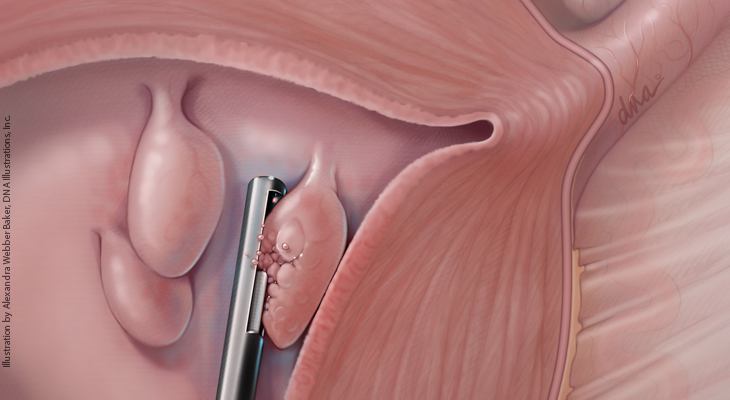
Figure 1
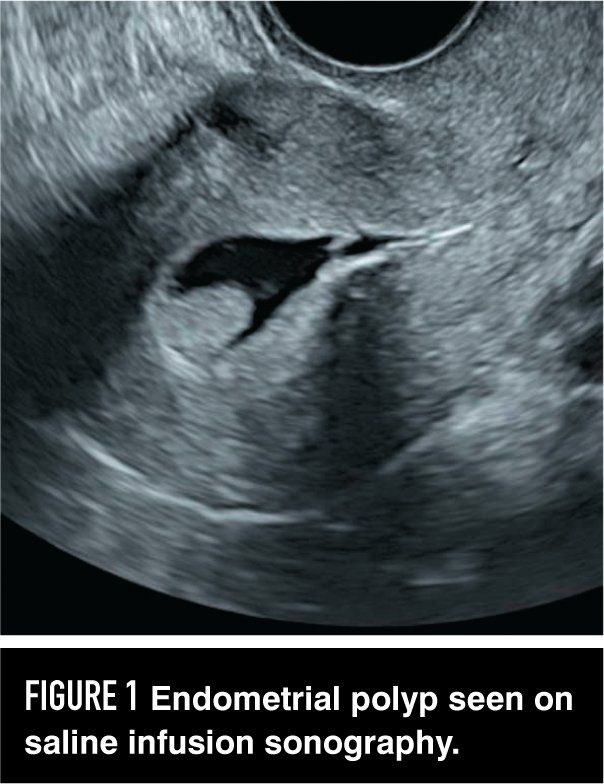
Figure 2a
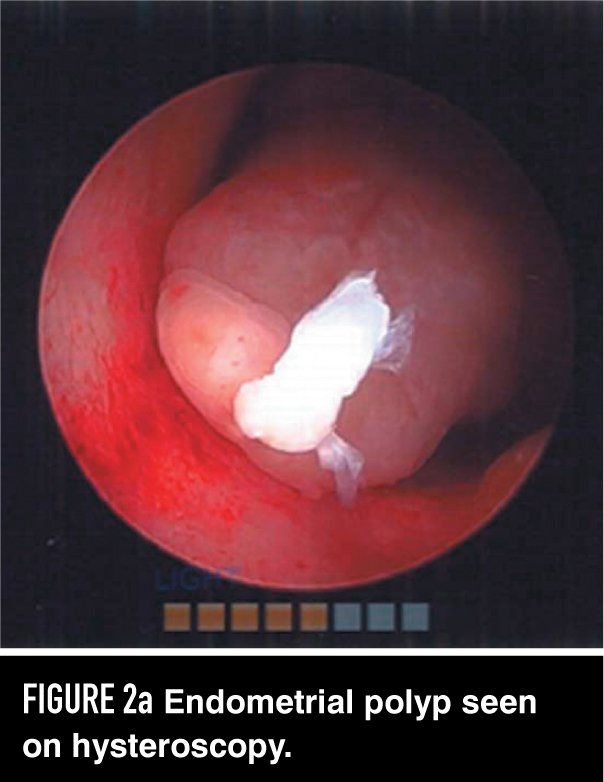
Figure 2b

Table 1

Table 2
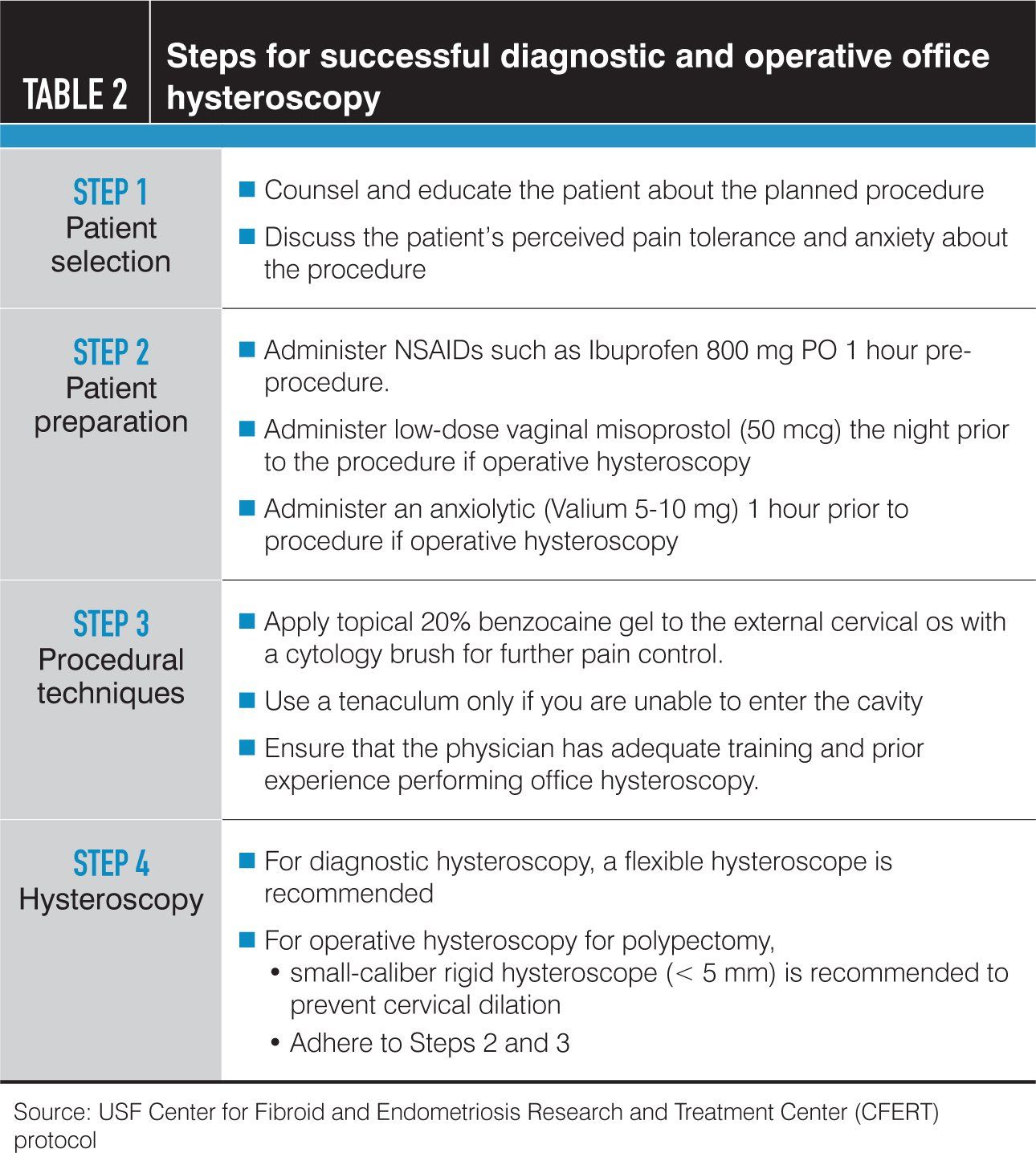
Table 3
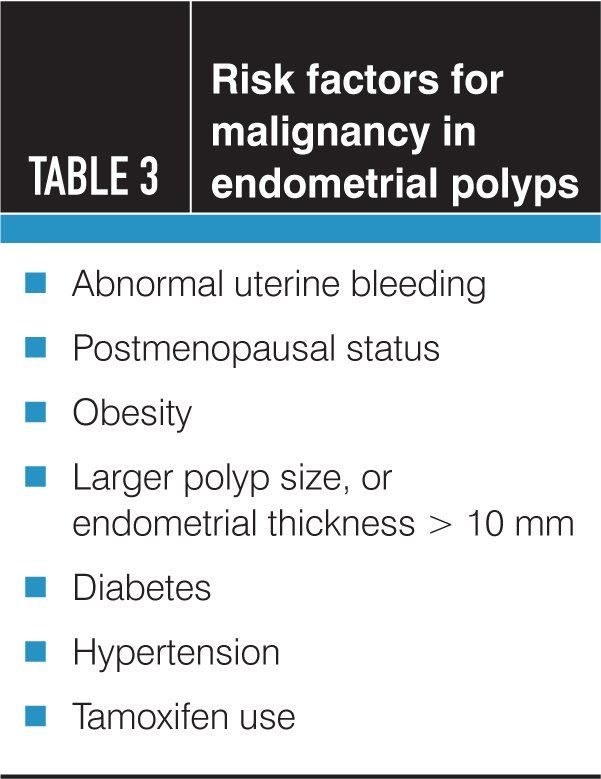
Endometrial polyps are common structural and epithelial abnormalities of the endometrium that are often encountered by gynecologists in office-based practice. These endometrial growths may be found incidentally in as many as 10% to 15% of asymptomatic women, and between 20% to 30% of women with abnormal uterine bleeding (AUB).1,2 Given their prevalence in patients presenting with AUB, polyps are considered as part of the FIGO classification for causes of abnormal uterine bleeding - PALM-COEIN.3 They may cause a variety of abnormal bleeding patterns, likely due to small muscular arteries found within the growths,4 but they can also be completely asymptomatic. Structural uterine pathologies often cause menstruation that is heavy or prolonged, albeit monthly,5 but polyps can also cause intermenstrual or postmenopausal bleeding.1 Endometrial polyps are usually benign but in 0.5% to 3% of cases, they are malignant.1
Endometrial polyps are thought to impact fertility, and removal is recommended prior to initiating treatment, especially before proceeding with in vitro fertilization (IVF). Some proposed mechanisms by which polyps are thought to impact fertility include inhibition of implantation, endometrial inflammation, mechanical blockage of sperm from fertilization, or changes in endometrial receptivity.6 In the infertile population, prevalence of polyps is thought to be between 11% and 45%, which is higher than in the general population.6,7 Hysteroscopic removal of endometrial polyps found incidentally during fertility evaluation is recommended, with one study showing post-polypectomy implantation rates during IVF to be similar to those in women who do not have endometrial polyps.7
True to their name, polyps may grow on a thin stalk from anywhere within the uterine cavity, or they may appear sessile: smooth and flat with a broad base. They typically measure up to about 3 cm.1 Histopathologically, polyps appear as cystic dilation of glands with mononuclear cells, often filled with mucous.4 They may contain vascular pedicles, connective tissue, and even glandular tissue.3 Their prevalence makes them an important pathology to study, so that proper diagnosis and treatment can be undertaken, with the gold standard being hysteroscopy.1
Making the diagnosis
Because AUB triggers further evaluation of potential etiologies, endometrial polyps are often diagnosed on ultrasound,2 as seen in Figure 1. The sonographic finding suggestive of an endometrial polyp is a bright, hyperechoic area visualized within the endometrium (Table 1).8 Using power doppler sonography may reveal a single-vessel pattern of blood flow to the polyp (sensitivity 81.2%, positive predictive value [PPV] 92.9%) compared to fibroids, which more often show an enhancing rim of vessels.9
In case you missed it - Patient handout: Endometrial polyps
If further characterization is needed, office hysteroscopy is considered the gold standard for further evaluation,1,10 however, saline infusion sonography (SIS) is another excellent diagnostic study9 with a sensitivity of 93% and specificity of 81% in diagnosing endometrial polyps.10 Hysteroscopy and SIS are best performed during the proliferative phase of the menstrual cycle shortly after cessation of menses. Hysteroscopy allows for direct visualization of the polyps while SIS with a skillful operator can also provide specific details, such as where the polyp is attached and its size.1 If there is uncertainty about presence of a polyp on transvaginal ultrasound, SIS can be used as the next step for better visualization, with a PPV of 88.5%, compared to only 65.2% with ultrasound alone.2
Polyp management
Because endometrial polyps are often the culprit in AUB, treatment is warranted to decrease a patient’s symptoms and confirm the diagnosis, especially because benign and malignant polyps cannot be reliably distinguished with imaging alone.11 Hysteroscopy with polypectomy is the treatment of choice, serving both as a diagnostic and therapeutic procedure.1 With office hysteroscopy now widely available, it is much easier to address polyps than in the past.5 Narrow-caliber hysteroscopes with diameters ranging from 2 to 3 mm and flexible hysteroscopes allow for these office procedures to be performed with minimal pain for patients.5 Office hysteroscopy can be used for both diagnosis and treatment and it has the ability to immediately confirm successful polyp removal; therefore, it serves as the gold standard for management of endometrial polyps (Figures 2a and 2b).1 When a polyp is visualized during office hysteroscopy, directed removal or biopsy should be performed, even if it is suspected to be benign.1
Office hysteroscopy as opposed to hysteroscopy performed in the operating room is the preferred method for management of endometrial polyps for a variety of reasons.5 Benefits for patients include reduced cost of medical services and time off from work, greater convenience, and more flexibility in scheduling the surgery.12 A recent study evaluating the effectiveness of office hysteroscopic removal of endometrial polyps showed that office hysteroscopy was successful in removing endometrial polyps 95.7% of the time, and while hysteroscopy in the operating room resulted in fewer residual polyps (98.1% successful), office hysteroscopy is still preferred due to the aforementioned benefits.8 Because of the convenience and cost savings associated with office hysteroscopy, many women are amenable to it, but special consideration has to be paid to patients’ pain and comfort during the procedure. Patients’ reported pain has been shown to be reasonable and tolerable, with an average reported pain score of 5 on the visual analogue scale, the classic pain scale ranging from 0 to 10.13 When selecting candidates for office hysteroscopy, individual patient self-assessment of pain tolerance and anxiety can help determine who would benefit most from an office-based procedure as opposed to an operating room procedure (Table 2).14 Determinants of successful office-based hysteroscopy for polyp removal are polyp number, size, and location; patient characteristics such as body mass index (BMI) and other comorbidities; availability of an appropriate hysteroscopic system; and physician experience and comfort level with the procedure.
Traditional mechanical instruments such as polyp scissors or grasping forceps introduced down the operative channel of a hysteroscopy as well as more modern tissue-extracting devices are both excellent ways of resecting polyps under direct visualization.1 The appeal of modern tissue removal systems such as TRUCLEAR, MyoSure, and the Integrated Bigatti Shaver is that they allow for mechanical cutting of tissue and suction extraction, ensuring full removal of the polyp and easy collection of tissue for further histopathologic evaluation and diagnosis.1 Blind, sharp dilation and curettage previously may have been performed for polypectomy, but it is no longer recommended because of its lack of targeted effect.1
Treatment of all visible endometrial polyps is recommended, but some patients decline removal, perhaps because they are asymptomatic. In those cases, data on the natural history of polyps may help guide clinical management. One retrospective study estimated that 6.3% of polyps may spontaneously resolve after 6 months in premenopausal women, however, 15% of these patients may develop AUB in that same time period.15 Hysteroscopic polypectomy should be recommended and advocated, especially in patients with higher risk factors for malignant transformation.
Although in polyps, risk of underlying malignancy is not very high, careful clinical evaluation to rule it out is critical.16 In postmenopausal women who have AUB, risk of finding precancerous pathology in polyps may be as high as 6%.17 Risk factors that increase concerns about cancer include: postmenopausal status (OR 8.274)8, obesity, AUB, polyp size, and even diabetes and hypertension.2,8 One study suggests that BMI > 32 or endometrial thickness > 10 mm increases risk of hyperplasia or malignancy.11 Use of tamoxifen, a common maintenance medication taken by women with a history of estrogen receptor-positive breast cancer or who are at risk of breast cancer, has been shown to increase risk not only of endometrial polyps, but of endometrial hyperplasia and cancer. It is thought that while tamoxifen has an anti-estrogenic effect on breast tissue, it may selectively promote proliferation in the endometrium (Table 3).16
Conclusion
Endometrial polyps, whether found on ultrasound during a workup for AUB or suspected to be the etiology of a patient’s infertility, are commonly encountered and easily managed with office-based hysteroscopic procedures. Given the underlying risk of malignancy in endometrial polyps, which may be as low as 0.5% to 3% in all women diagnosed with polyps1 or up to 6% in postmenopausal women presenting with bleeding,17 removal is strongly recommended with hysteroscopic polypectomy for eventual histopathologic diagnosis.
Disclosures:
The authors report no potential conflicts of interest with regard to this article.
References:
- Clark TJ, Stevenson H. Endometrial polyps and abnormal uterine bleeding (AUB-P): what is the relationship, how are they diagnosed and how are they treated? Best Pract Res Clin Obstet Gynaecol. 2017 Apr;40:89-104.
- Fadl SA, Sabry AS, Hippe DS, et al. Diagnosing polyps on transvaginal sonography: is sonohysterography always necessary? Ultrasound Q. 2018 Dec;34(4):272-277.
- Munro MG, Critchley HO, Broder MS, Fraser IS. FIGO classification system (PALM-COEIN) for causes of abnormal uterine bleeding in nongravid women of reproductive age. FIGO Working Group on Menstrual Disorders. Int J Gynaecol Obstet. 2011;113:3–13.
- Kumar, Vinay, et al. Robbins Basic Pathology (9th ed.). Philadelphia, Pennsylvania: Saunders/Elsevier; 2012; 690-693.
- Fritz MA, Speroff L. Clinical gynecologic endocrinology and infertility. Philadelphia, Pennsylvania: Lippincott Williams & Wilkins; 2011; 602-612.
- Al Chami A, Saridogan E. Endometrial polyps and subfertility. J Obstet Gynaecol India. 2017 Feb;67(1):9-14.
- Yang JH, Yang PK, Chen, MJ, et al. Management of endometrial polyps incidentally diagnosed during IVF: a case-control study. Reprod Biomed Online. 2017 Mar;34(3):285-290.
- Luerti M, VitaglianoA, Di Spiezio Sardo A, et al. Effectiveness of hysteroscopic techniques for endometrial polyp removal: the Italian Multicenter Trial. J Minim Invasive Gynecol. 2018 Dec 7. pii: S1553-4650(18)31402-X. [Epub ahead of print]
- Cil AP, Tulunay G, Kose MF, Haberal A. Power Doppler properties of endometrial polyps and submucosal fibroids: a preliminary observational study in women with known intracavitary lesions. Ultrasound Obstet Gynecol. 2010;35:233–237.
- Bittencourt CA, Dos Santos Simões R, Bernardo WM, et al. Accuracy of saline contrast sonohysterography in detection of endometrial polyps and submucosal leiomyomas in women of reproductive age with abnormal uterine bleeding: systematic review and meta-analysis. Ultrasound Obstet Gynecol. 2017 Jul;50(1):32-39.
- Ghoubara A, Sundar S, Ewies AAA. Predictors of malignancy in endometrial polyps: study of 421 women with postmenopausal bleeding. Climacteric. 2018 Feb;21(1):82-87.
- American College of Obstetricians and Gynecologists. Technology assessment No. 7: hysteroscopy. Obstet Gynecol. 2011 Jun;117(6):1486-1491.
- New EP, Sarkar P, Sappenfield E, et al. Comparison of patients reported pain following office hysteroscopy with and without endometrial biopsy: a prospective study. Minerva Ginecol. 2018 Dec;70(6):710-715.
- Ireland LD, Allen RH. Pain management for gynecologic procedures in the office. Obstet Gynecol Surv. 2016 Feb;71(2):89-98.
- Wong M, Crnobrnja B2, Liberale V, et al. The natural history of endometrial polyps. Hum Reprod. 2017 Feb;32(2):340-345.
- Runowicz CD, Costantino JP, Wickerham DL, et al. Gynecologic conditions in participants in the NSABP breast cancer prevention study of tamoxifen and raloxifene (STAR). Am J Obstet Gynecol. 2011 Dec; 205(6):535.e1-5.
- Vroom AJ, Timmermans A, Bongers MY. Diagnostic accuracy of saline contrast sonohysterography to detect endometrial polyps in women with postmenopausal bleeding: a systematic review and meta-analysis. Ultrasound Obstet Gynecol. 2019 Jan 28.
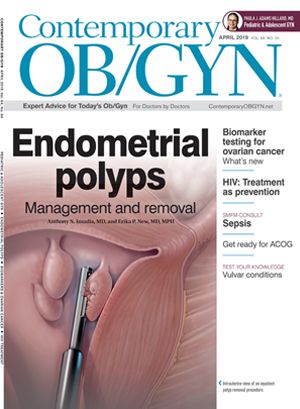
Study finds high rates of incidental MRI findings in endometriosis cases
October 29th 2024A recent study highlights the frequent occurrence of incidental findings on pelvic magnetic resonance imaging for endometriosis, emphasizing the need for radiologists to focus on those with higher clinical significance.
Read More
